Many of us dream of owning our very own smallholding, growing vegetables, keeping animals and harvesting fruit for fresh, seasonal recipes.
Kathy Bishop and Tom Crowford moved to Somerset to do just that, and we caught up with them to find out what it takes to run your own smallholding, from starting out and picking the right things to grow, to recipe ideas and valuable lessons learnt along the way.

Our guide to starting your own smallholding, including growing, harvesting and seasonal, country recipes.
It’s hard to pinpoint exactly where our smallholding dream began, but it certainly had a lot to do with honeybees. We had read about these fascinating insects and their worrying decline and wanted to do our bit to help. Keeping a hive of our own and creating a garden filled with bee-friendly plants seemed a good place to start.
At around the same time, we developed an interest in the slow food movement, seasonal eating and home-grown fruit and vegetables, and were keen to explore it more. So when we spotted a garden flat for rent near to where we were living in the London suburbs, we quickly arranged the move, and set about creating our version of the good life in the city.

With the guidance of a few books, a beekeeping course, and some trial and error, we got going. We dug in some vegetable beds, potted up a hotchpotch of plants, and put a beehive on the patio.
How much space do you need for a smallholding?
It was on this small scale that we realised the joy of growing and eating our own produce. Bowls of freshly picked salad leaves and soft garden herbs eaten outside on a summer evening. The crunch and intense flavour of a mud-dusted carrot pulled straight from the earth. Floral honey, drizzled over buttered toast. It wasn’t long before we found ourselves dreaming of moving again, but this time to the countryside, where we might have the space to grow more food, expand the apiary, keep animals and be as self-sufficient as possible.
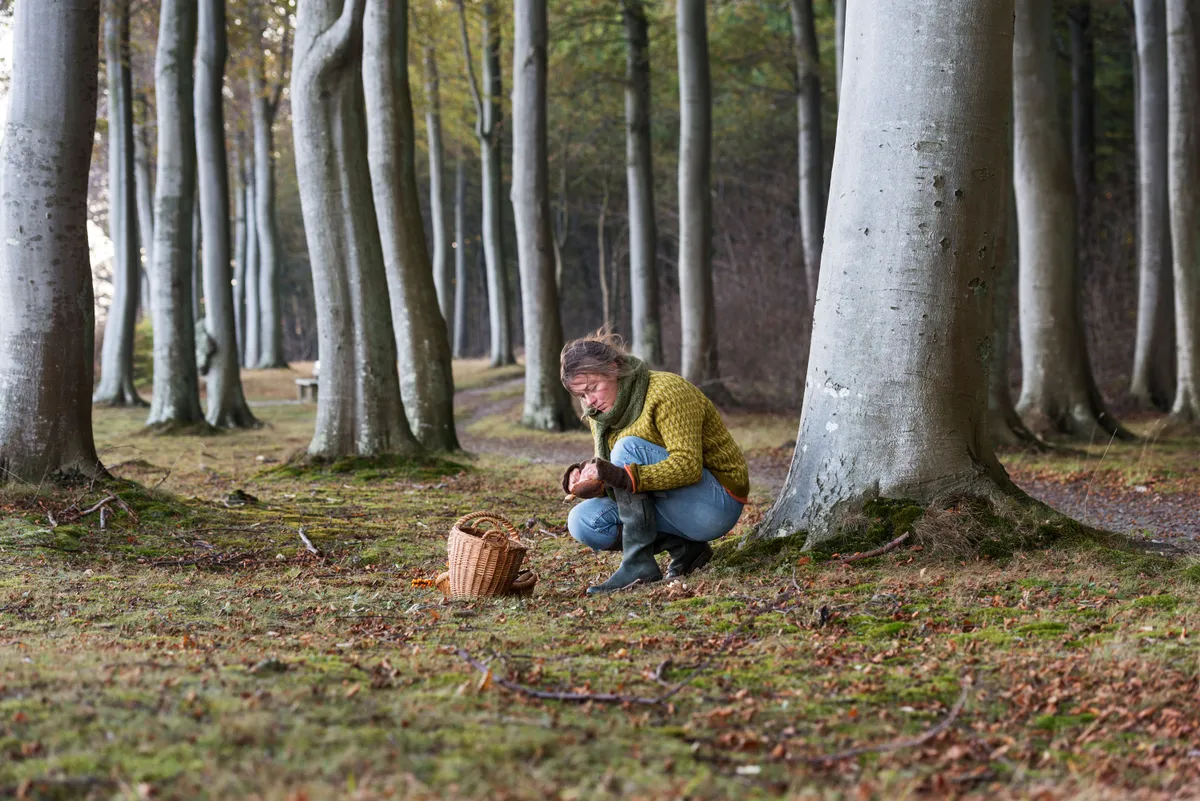
We decided to move to Somerset (a county we already knew quite well) to find a smallholding to buy. After months of looking, we found a little stone cottage on the edge of a village that came with just over 1.5 acres of land, including a wonderful – if slightly neglected – orchard, a small paddock and a wonky fruit cage. In the spring of 2014 we moved in.
What is life on a smallholding like?
Adjusting to rural life came easily and we settled in quickly. We love having nature on our doorstep and being able to walk in the surrounding countryside. The biggest challenge has been balancing the smallholding with our full-time jobs. Our task list is endless and there’s never time to do everything we would like to, but we enjoy it enormously and try to keep things manageable by developing the smallholding slowly.

What are the best vegetables to grow?
The first thing we did was replace a sunny spot of lawn with some raised beds to create an organic vegetable patch. We also refurbished the fruit cage and began work on pruning the orchard into shape. We grow a wide array of kitchen staples, many of which are interesting varieties that aren’t typically available to buy in the supermarket, such as purple sweetcorn (a variety called Double Red), candy-striped beetroot (Barbabietola di Chioggia) and rainbow carrots, as well as more unusual things such as medlars, mulberries and Chilean guava.

Smallholding projects
Next, we built the log stores. We rely on wood burners for heating, so chopping and stacking wood is a year-round task to ensure we always have well-seasoned firewood ready to use. Since then we’ve embarked on various projects. We planted a herb patch full of well-known favourites, as well as herbs we’d always wanted to try, such as sorrel, salad burnet (which tastes like cucumber) and the softly citrus leaves of lemon verbena. We grafted new apple varieties in the orchard; installed fencing; made an apple press, which we use to process the autumn harvests into juice, wild-fermented cider and vinegar; built a composting system; made our own charcoal from the orchard prunings, which we use to cook outside, and, of course, added some livestock on our land.

Best animals for a smallholding
We did a lot of research to identify animals and breeds that would work the land as sustainably as possible and be well-suited to smallholding life. We began with a gaggle of tubby geese, who are an eco-friendly, grass-fed alternative to the rickety ride-on mower that came with the cottage, as well as producers of enormous chalk-white eggs for the kitchen.
Next came the chickens. We are in the process of developing a thrifty, dual-purpose flock who provide delicious meat and multicoloured eggs. One of the most rewarding moments was when the chickens started laying; our egg racks are a cheerful rainbow of dark brown, pastel pinks and blues, speckled terracotta and olive. Our most recent additions are some hardy Shetland sheep who will produce meat, wool, and milk.

What problems come with having a smallholding?
Smallholding has been a wonderful experience so far, but things don’t always go smoothly. One of the trickiest incidents was the intrusion of an inquisitive herd of cows from the field next door while we were at work. They destroyed the electric fencing, terrified the sheep, knocked over a beehive, left the fruit cage in tatters and trampled the vegetable patch. Luckily, some kindly neighbours sprang into action and, with a lot of arm-waving, managed to encourage the cows (who were having a lovely time) to return to their field. Tidying up afterwards took ages, but it wasn’t all bad: the herd’s farmer sheared our sheep by way of an apology, and we were left with lots of cowpat fertiliser to use in the garden.
What are the benefits of a smallholding?
Perhaps the thing we love most about living here is the connection it gives us to food. Being able to pop outside and choose what to eat that day from whatever is ready to harvest is a simple pleasure we never tire of. We also spend a lot of time out foraging for wild ingredients to supplement what we grow. Our kitchen remains busy throughout the year so we can enjoy the produce at its best, as well as preserve and squirrel things away to ensure nothing goes to waste.

Eating seasonally and focussing meals around ingredients we can source from our land, the wild, or local producers, has totally transformed the way we cook and think about food for the better.
Top tips for owning a smallholding
1. Create Compost
We built some compost bins a couple of years ago and only wish we’d done it sooner. All our green waste and animal bedding is now transformed into nutrient-rich soil for the vegetable patch.
2. How much land do you need?
When we started thinking about producing our own food, we wrongly assumed we would need many acres of land to do it, but it’s amazing how much can be grown on a small plot.
3. Don’t be afraid to change
We initially spent a lot of time on a flowerbed left by the previous owners, as we felt bad removing it. Eventually, we incorporated it into the veg patch, where it plays a more practical role.
4. Invest in Tools
We made the mistake of buying some cheap tools that weren’t up to the smallholding tasks and had to replace them after a few uses. We’ve now invested in quality tools, which we hope will last many years.
5. Remember to relax!
Smallholding is super busy – there is always something that needs attention – but don’t forget to take the time simply to sit and enjoy it, ideally with a mug of tea in hand.
Smallholding recipes
Wild garlic, nettle and dandelion tart

This is one of our favourite recipes to make in spring when the first of the wild garlic appears. We combine it with dandelion leaves and young stinging nettles, both of which are usually in abundance at this time of year, as well as lots of mature Cheddar cheese to make a delicious tart for the table.
Wild garlic, nettle and dandelion tart recipe
Borage leaf, pea and garden mint soup

Late spring and the smallholding is a hub of activity. The geese are laying eggs all over the orchard, the sheep are ready for shearing, and there is a broody chicken in the coop. We’re busy seed-sowing, plant-potting and keeping an eye on the beehives for signs of swarming. In the vegetable beds, this season’s newest crops have appeared in wonky rows. Spring onions, twirling pea shoots and fistfuls of borage leaves and flowers are among the pickings.
Borage leaf, pea and garden mint soup recipe
Summer garden salad
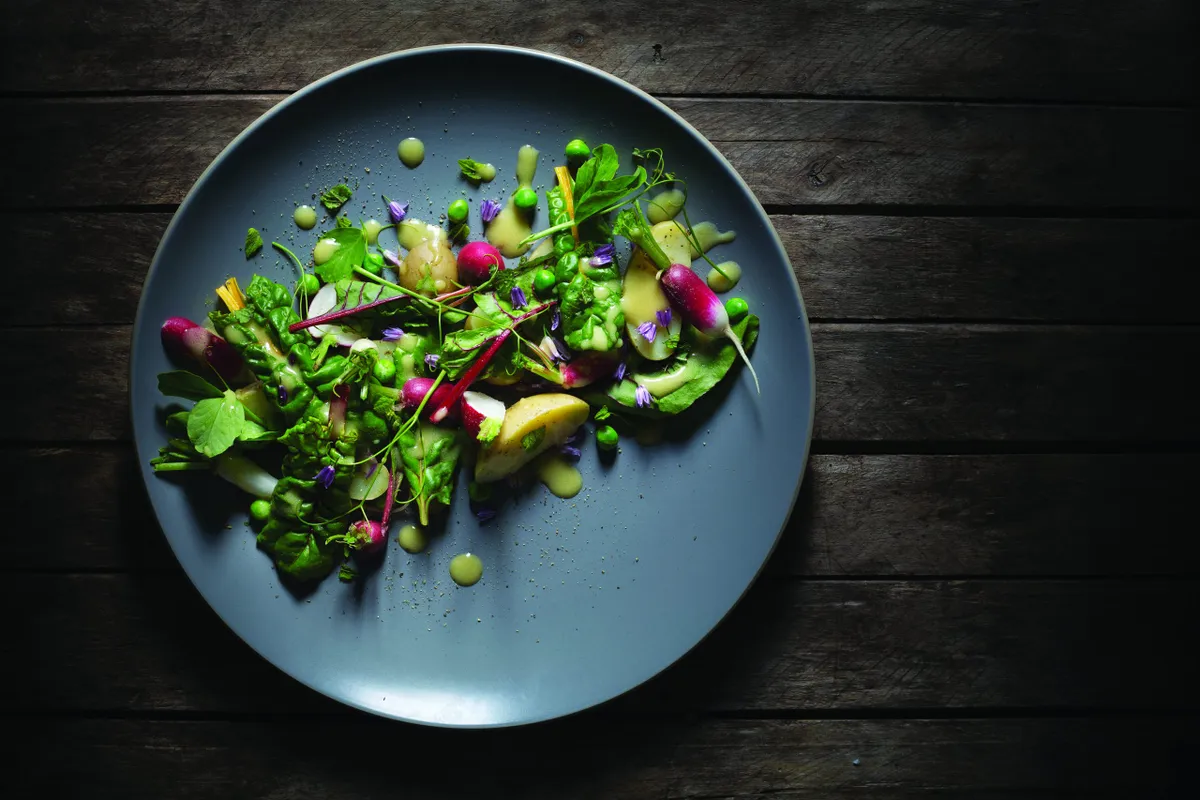
The vegetable and herb patches are busy this month. We sow radishes and lettuces every couple of weeks to ensure a continuous kitchen supply. Scruffy pots of tomatoes are moved on to the sunny patio and courgettes are planted out.
We cut bunches of oregano and mint to dry. There are waxy new potatoes to harvest and main-crop varieties to earth-up. Dinner is often a simple salad, quickly assembled from whatever is ready to pick, and eaten outside with crusty bread.
Summer garden salad recipe
Gooseberry soda
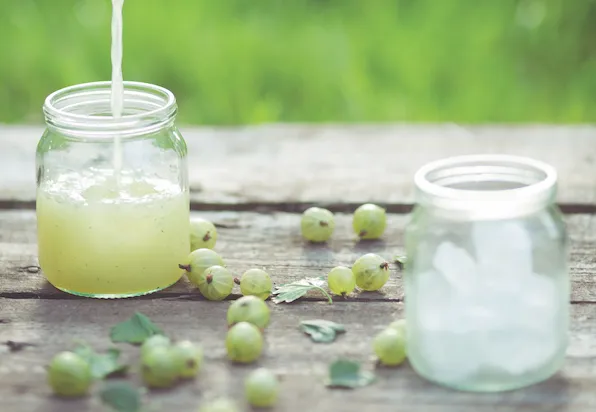
Feathers blanket the orchard. Our geese are mid-moult and feeling sorry for themselves. Luckily, summer fruits provide a cheerful distraction. Early plums and crimson cherries, plus dusky blackcurrants, pink raspberries and plump strawberries from the fruit cage. The tubby gaggle gathers around our boots as we pick, ready to catch any falling fruit. They also waddle over to the gooseberry patch to scrump the aptly named berries. We turn what is left into one of our favourite summer drinks.
Gooseberry soda recipe
Nasturtium, halloumi and courgette omelette

Harvest, preserve, repeat. We do this year-round, but never more so than in August. Berries and plums are turned into jams and compotes. The first apples are ready to pick and dry in rings. Veg patch surplus is made into soup for the freezer, or store cupboard pickles. The kitchen table is covered with sticky honey jars. And there are racks of rainbow-coloured eggs, which we use for fresh pasta, mayonnaise, cakes and, of course, breakfast. This quick and tasty supper is a summer delight.
Nasturtium, halloumi and courgette omelette recipe
Wild mushroom and black kale tagliatelle
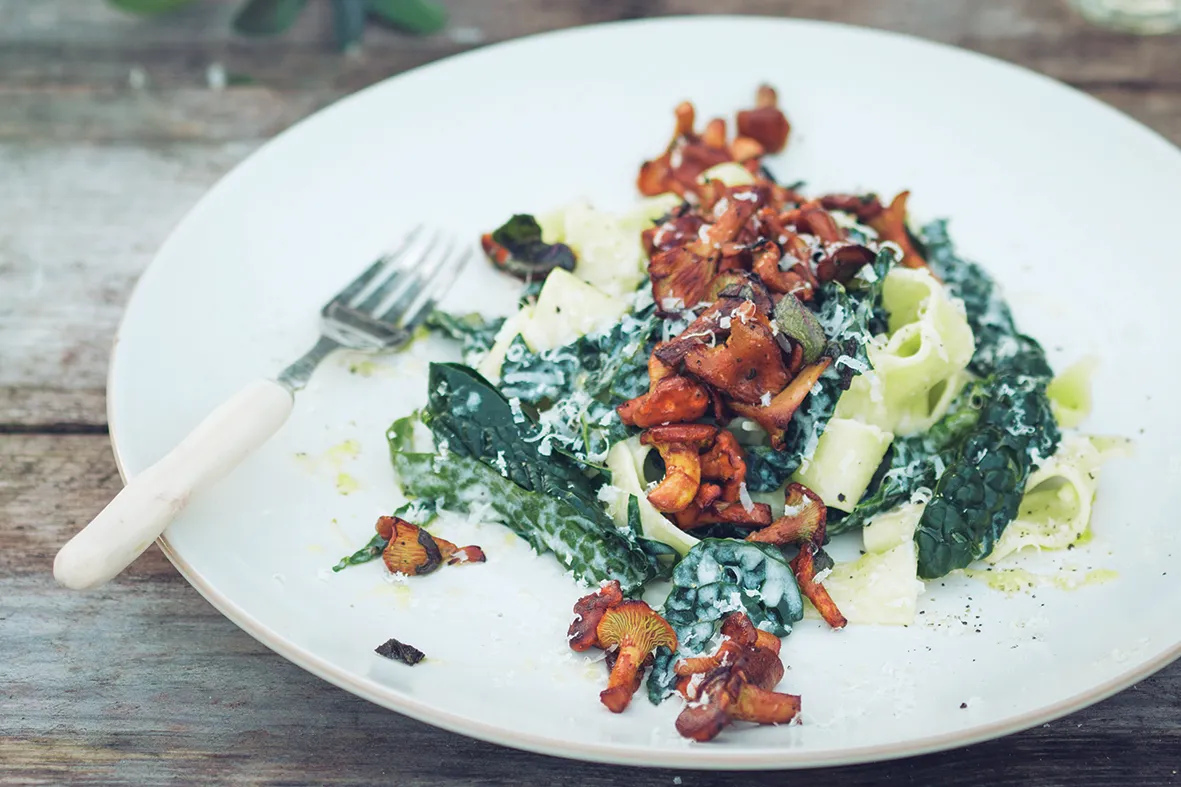
Autumn is here. Leaves need raking and barrowing to the mulching cage. Seasoned wood is emptied from logstores and brought inside for the fire. We give the vegetable patch a tidy: soggy, frost-hit nasturtiums and withered courgette stems are cleared, brassicas are checked for covert caterpillars and winter salad crops are thinned. There is a hotchpotch of apples to press and pears to harvest by the basketful. Wild mushrooms are also ready to gather, so to the woodland we go.
Wild mushroom and black kale tagliatelle recipe
Onion, leek and bay soup
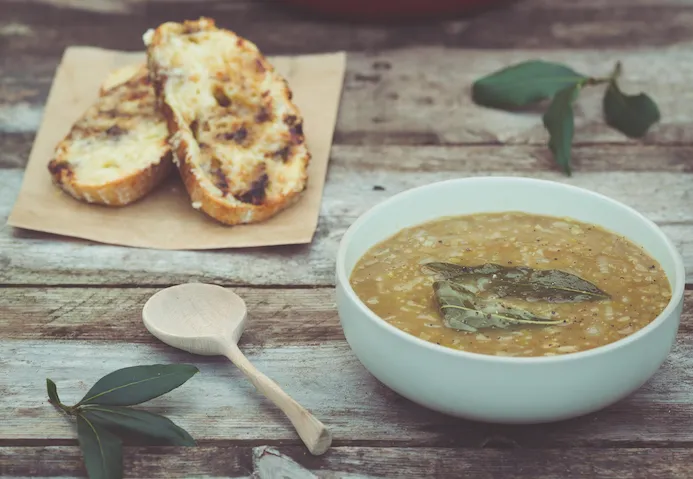
We’re slowly winding down for winter. Hay is stacked for the sheep, and the beehives are tucked up with insulation. The last orchard medlars need picking. There are leeks to harvest from the vegetable patch, while onion and garlic sets need planting. In the kitchen, this year’s braided alliums dangle from the ceiling between a bubbling tank of cider, which is almost ready to bottle, and empty egg racks (the chickens are on a break). Dinner is often deep bowls of soup. Comfort for cold nights.
Onion, leek and bay soup
The Seasonal Table
Kathy and Tom combine running their Somerset smallholding with full-time jobs, and also find time to write a blog called The Seasonal Table – a journal of slow food and slow living.
Find out more about The Seasonal Table:
Words and pictures by Kathy Bishop and Tom Crowford.